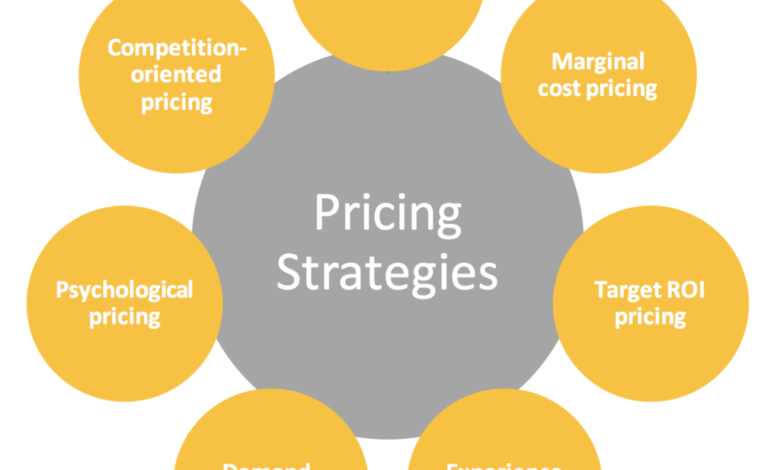How To Decide Pricing Strategy

Introduction to Pricing Strategies
Welcome to our blog post on pricing strategies! Pricing is a crucial element of any business strategy, as it directly impacts your profitability and customer perception. Whether you’re a small startup or an established enterprise, finding the right pricing strategy can make all the difference in achieving success.
In this article, we will explore various pricing strategies that can help you determine how much to charge for your products or services. From cost-based and value-based approaches to competition-based and psychological tactics, we’ll cover them all. So let’s dive in and discover the secrets behind effective pricing strategies!
Remember, selecting the appropriate pricing strategy requires careful consideration of multiple factors unique to your business. It’s not just about randomly assigning numbers; it involves analyzing costs, understanding customer perceptions, evaluating market conditions, and keeping an eye on competitors.
Cost-Based Pricing Strategy
One common approach to pricing products or services is the cost-based pricing strategy. This method involves determining the price by considering the costs involved in producing and delivering a product, as well as adding a desired profit margin.
When using this strategy, businesses calculate their expenses, such as raw materials, labor, overhead costs, and any other relevant expenses. They then add a markup to cover their desired profit margin. The final price should reflect not only these costs but also market factors and customer demand.
It’s important for companies to have a clear understanding of their production costs before implementing this pricing strategy. By accurately calculating all expenses associated with creating their products or providing their services, they can ensure that they set prices that will generate enough revenue to cover both variable and fixed costs while still making a profit.
Furthermore, it’s crucial for businesses to consider external factors when using cost-based pricing. Market conditions and customer demand can significantly impact pricing decisions. A thorough analysis of competitors’ prices and industry trends will help determine if the chosen markups are suitable for attracting customers while remaining profitable.
Utilizing the cost-based pricing strategy involves carefully assessing production costs along with desired profitability goals. By taking into account both internal factors like expenses and external factors like competition and market demand, businesses can establish appropriate prices that align with their financial objectives
Value-Based Pricing Strategy
When it comes to determining the price of a product or service, one approach that businesses often use is the value-based pricing strategy. This strategy focuses on setting prices based on the perceived value that customers derive from the offering.
In this approach, rather than looking solely at production costs or competitor pricing, businesses consider factors such as customer preferences and willingness to pay. By understanding what customers are willing to pay for a particular product or service and how much value they perceive in it, companies can set prices accordingly.
To implement a value-based pricing strategy effectively, businesses need to thoroughly research their target market and understand their customers’ needs and desires. They must also be able to differentiate their offering from competitors by highlighting unique features or benefits that add significant value.
By aligning the price with the perceived value provided by the product or service, businesses can maximize profitability while satisfying customer expectations. It allows for higher prices when there is high demand or when there are additional benefits that justify a premium price point.
However, implementing a value-based pricing strategy requires ongoing monitoring and adjustments. Market conditions change over time, so regular evaluation of customer perceptions and competitive offerings is essential for ensuring continued success.
Employing a value-based pricing strategy enables businesses to capture more of the economic surplus created by providing superior products or services compared to competitors. By focusing on delivering exceptional value and charging accordingly, companies can achieve long-term profitability while maintaining satisfied customers.
Competition-Based Pricing Strategy
In today’s competitive business landscape, pricing your products or services appropriately is crucial for staying ahead of the competition. A competition-based pricing strategy involves setting prices based on what your competitors are charging for similar offerings.
When implementing a competition-based pricing strategy, it’s important to carefully research and analyze your competitors’ pricing structures. Look at the prices they charge for comparable products or services and determine how you can position yourself competitively in the market.
It’s essential to consider factors such as product quality, features, and brand reputation when determining your pricing strategy. If you offer superior value compared to your competitors, you may be able to justify higher prices. On the other hand, if you want to attract price-sensitive customers or gain market share quickly, you might choose to set lower prices than your rivals.
Keep in mind that while competition-based pricing can help inform your decisions, it shouldn’t be the sole factor driving them. It’s important to also consider other elements such as production costs, profit margins, and customer demand.
Regularly monitoring and adjusting your prices in response to changes in the competitive landscape is crucial for success with this strategy. Stay informed about industry trends and adjust accordingly to maintain a competitive edge.
By employing a well-researched competition-based pricing strategy tailored specifically for your business needs, you’ll be better positioned to succeed amidst tough market conditions.
Psychological Pricing Strategy
One effective pricing strategy that businesses can employ is the psychological pricing strategy. This approach takes advantage of human psychology to influence consumer behavior and perception of price.
One common tactic within this strategy is using “charm prices,” which are prices that end in 9 or 99. For example, setting a product’s price at $19.99 instead of a rounded $20 can make it seem more affordable and appealing to consumers.
Another technique is anchoring, where businesses display a higher-priced item next to their target product. By doing so, the target product appears more reasonably priced in comparison.
Limited-time offers and scarcity tactics can also be employed as part of the psychological pricing strategy. Creating a sense of urgency through phrases like “limited stock” or “for a limited time only” can push consumers to make quicker purchasing decisions.
Additionally, bundling products together at a slightly discounted price compared to buying them individually can give customers the perception that they are getting more value for their money.
When implementing the psychological pricing strategy, it’s essential for businesses to understand their target audience and test different approaches to see what resonates best with their customers’ psyche.
By utilizing these techniques, businesses have the opportunity to influence consumer behavior positively and drive sales while maintaining profitability. The key lies in finding the right balance between enticing customers with attractive prices while still ensuring adequate profit margins.
Dynamic Pricing Strategy
Dynamic Pricing Strategy is a pricing approach that involves adjusting prices in real-time based on various factors such as demand, competition, and market conditions. It allows businesses to maximize their revenue by charging different prices for the same product or service at different times.
One of the key benefits of dynamic pricing is its ability to respond quickly to changes in the market. By analyzing data and monitoring trends, businesses can set optimal prices that reflect current supply and demand dynamics. This flexibility enables them to capture maximum value from customers who are willing to pay more during peak periods while still attracting price-sensitive consumers during off-peak times.
Dynamic pricing is commonly used in industries such as airlines, hotels, ride-sharing services, and e-commerce platforms. For example, airlines often adjust ticket prices based on factors like time until departure, seat availability, and competitor fares. Similarly, online retailers may change product prices based on customer browsing behavior or inventory levels.
Implementing dynamic pricing requires robust data analysis capabilities and advanced technology tools. Businesses need access to relevant market information as well as sophisticated algorithms that can process large volumes of data in real time. Additionally, it’s important for companies using this strategy to carefully consider how price changes will be communicated to customers in order to maintain transparency and trust.
Factors to Consider When Choosing a Pricing Strategy
When it comes to pricing your products or services, there are several factors that you need to consider. Each business is unique, and what works for one may not work for another. Here are some key considerations when choosing a pricing strategy:
1. Customer Demand: Understanding the demand for your product or service is crucial in determining the right price point. Conduct market research and analyze customer behavior to identify their willingness to pay.
2. Competitor Analysis: Keep an eye on your competitors’ pricing strategies. Are they offering similar products at lower prices? Or do they differentiate themselves through premium pricing? This information will help you position yourself effectively in the market.
3. Cost Structure: Calculate all costs associated with producing and delivering your product or service. Determine if a cost-based pricing approach aligns with your profit goals.
4. Value Proposition: Consider the value that customers perceive from using your offerings compared to alternatives in the market. A value-based pricing strategy focuses on capturing this perceived value by setting higher prices.
5. Market Positioning: Your target market’s perception of your brand plays a vital role in determining price elasticity and profitability potential.
6. Profit Margins: Assess how different price points will impact your profit margins and overall financial health of the business.
7. Target Customer Segment: Different customer segments have different purchasing powers, needs, and expectations – tailoring prices based on these groups can lead to increased sales volumes or higher profits per unit sold.
8. Environmental Factors: Economic conditions, trends,social aspects, political events should also be considered as they influence consumer buying behavior
9. Long-term Goals : Aligning short term revenue goals with long term growth objectives is important while deciding upon prices.
By carefully considering these factors, you can choose a strategic pricing approach that maximizes revenue while still meeting customer expectations.
Implementing and Adjusting Your Pricing Strategy
Implementing and adjusting your pricing strategy is a crucial step in ensuring the success of your business. Once you have chosen the appropriate pricing strategy, it is important to effectively implement it across all aspects of your operations. This includes clearly communicating the prices to your customers, training sales staff on how to present and justify the prices, and regularly reviewing customer feedback.
One key aspect of implementing your pricing strategy is setting clear objectives and goals. What do you hope to achieve with your pricing? Are you aiming for increased market share or higher profit margins? By defining these goals, you can better align your pricing decisions with overall business objectives.
Another important consideration when implementing a pricing strategy is monitoring and analyzing market trends and competitor behavior. Keep an eye on changes in customer preferences, as well as any shifts in industry dynamics that may impact demand or price elasticity. Additionally, stay informed about what competitors are doing – are they lowering their prices or offering discounts? This information will help inform adjustments to your own pricing approach.
Once implemented, it’s essential to continuously evaluate and adjust your pricing strategy based on real-time data and insights. Regularly review sales performance metrics such as revenue growth, profitability per product/service line, customer acquisition rates, and customer churn rates. Analyzing this data will provide valuable insights into whether adjustments need to be made.
When making adjustments to your pricing strategy, take a systematic approach by testing different scenarios using techniques like A/B testing or conducting surveys among existing customers. This allows you to gauge their willingness-to-pay at different price points while minimizing potential risks associated with drastic changes.
Always keep an eye out for external factors that could impact the effectiveness of your current pricing strategy – economic conditions (e.g., inflation), industry regulations (e.g., taxes), or even technological advancements that may disrupt traditional business models.
Conclusion
Choosing the right pricing strategy for your business is a crucial decision that can greatly impact your bottom line. By understanding the different pricing strategies available and considering factors such as costs, value, competition, psychology, and market dynamics, you can make an informed choice.
Cost-based pricing allows you to cover your expenses and ensure a profit margin. Value-based pricing focuses on capturing the perceived value of your product or service in the minds of customers. Competition-based pricing helps you stay competitive in the marketplace by aligning your prices with similar offerings. Psychological pricing leverages consumer behavior to influence purchasing decisions. Dynamic pricing enables you to adjust prices based on various factors such as demand fluctuations or seasonality.
When implementing a pricing strategy, it’s important to monitor its effectiveness continuously. Regularly analyze sales data, customer feedback, and market trends to identify any necessary adjustments. Keep in mind that no single approach will work for every situation or industry – what works for one business may not work for another.
Remember that finding the optimal price point requires experimentation and flexibility. Don’t be afraid to test different strategies until you find what resonates best with your target audience and delivers maximum profitability.
Selecting a successful pricing strategy involves careful consideration of multiple factors related to costs, value proposition differentiation from competitors’ offerings along consumer behavior patterns influencing their purchase decisions; furthermore using dynamic pricing techniques when appropriate could lead to achieving desired results effectively.




